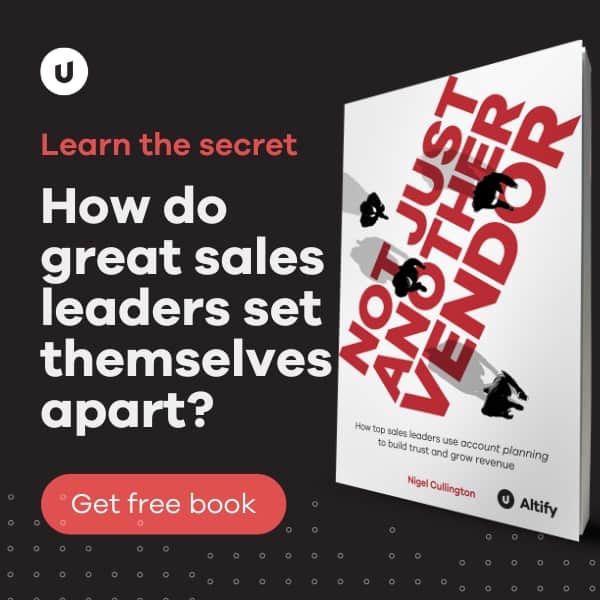This post is (mainly) an extract from of an article written by a friend of mine, Paul O’Dea, CEO of Select Strategies. The article tells the story of the growth of Innocent, a company that started in 1998 selling 100% natural smoothies and other drinks. While Innocent’s marketing is firmly targeted at the consumer, aping the clarity of its image and message is something many B2B companies and B2B sales people could learn from, so I thought I share this extract from Paul’s article.
– o – o – o –
Innocent was launched in 1999, and ten years on, has over two thirds of the UK smoothie market, selling two million smoothies a week. Their smoothies are delicious and 100 percent natural, but that doesn’t explain their success. The three founders came from advertising and marketing backgrounds, not food. They didn’t know more than anyone else about ingredients or health. But they understood messaging. As Maurice Pinto, their first angel investor, said: “They wanted to start a company with the idea of creating a brand. Smoothies were simply the vehicle.”
Innocent created their brand by ensuring their core messages – to be natural, responsible, generous, and enjoy life – were delivered across all company activities. From the jokey design of the labels, to the relaxed, humorous way they deal with customers, to the insistence on natural and recyclable ingredients, to the donation of profits to charity, to the adventurous staff off-sites, Innocent has developed a consistent, attractive brand which consumers are willing to pay a little more for. Whether this savvy, hip company will survive selling out to Coca-Cola remains to be seen – but the fact that customers felt betrayed enough to urge a boycott of their products shows the kind of brand loyalty they built up. Ironically, Innocent’s consistent messaging put them in the position to ‘betray’ it.
Consumer marketing has traditionally been sophisticated. B2B selling is seen as different but in today’s commoditised world, maybe we can learn from consumer marketing. Ask yourself: can you really differentiate just on product or service? Or is it time to follow Innocent and look to your messaging?
MESSAGE IN BRIEF
- Message creation is hard, but where a lot of companies fall down isn’t message creation, but delivery. The B2B market has a lot to learn about messaging from the consumer market.
- All employees – not just marketing – should be on-message. Consistent messaging pervades all company activities. Gear everything, from font size on the website to how employees interact at trade fairs, to delivering the message.
- Good messaging is all about discipline, and like all disciplines, shouldn’t be left to chance, but needs to be embedded.
But in our experience, although message creation is hard, where a lot of companies fall down isn’t creation, but delivery.
Messaging: Creation and Delivery
There are two sides to messaging: creating and delivering. Message creation is crucial – you have to nail what makes you different to your competitors and explain it in clear, engaging terms. But in our experience, although message creation is hard, where a lot of companies fall down isn’t creation, but delivery.
Typically a company’s leadership crafts a message, conveys it to marketing, and moves onto other concerns. The message isn’t hammered home to staff and doesn’t pervade company activities in a consistent way. It gets lost and confused in sloppy copy. Unless all staff are on-message, expect drift, confusion, and apathy. There is little point in spending money on things like websites unless you get your own house in order first. Customers are not fooled by lipstick on the pig.
Step One: Face-to-face
The most cost-effective and impactful messaging comes from the interaction of your employees with customers. That’s all your employees, not just sales and marketing. In Innocent, there’s no strict division between marketing, design, sales, HR – all employees take turns answering the ‘bananaphone’ and showing customers around the headquarters, Fruit Towers. One of Innocent’s core philosophies is ‘treat the customer as a friend’ – which means warmly, informally and humorously.
Your motto may not be ‘treat the customer as a friend’. You may prefer more formal dealings. But whatever the message is, all employees should understand it and let it dictate behavior, from greeting through small-talk. If marketing adopts a laid-back approach but design is stiffly formal, you’ve got a messaging problem.
Step Two: When everything falls into place
When everyone’s on-message, all aspects of the company, both internal and external, fall into place. The whole way you do business, from the font size on your website, to the way you answer the phone, to the way your employees interact at customer meetings, delivers a clear consistent message.
At Innocent they’re obsessive about detail, so it’s no surprise that the font on their website is lower-case and bouncy, that employees can apply for scholarships to do something life-affirming like climb Kilimanjaro, that they use cornstarch, not plastic bottles, and that their hybrid, low carbon-emitting vans are painted like cow hides. You may not be as right-on and friendly as Innocent, but you should be as consistent.
Step Three: Embed Discipline
Once you’ve created the process which enables the whole team to remain on-message, stick with it relentlessly. Messaging needs constant attention. It’s about discipline, and like all disciplines shouldn’t be left to chance, but needs to be embedded. Everyone accepts that accounts need constant checks and audits or they get out of hand. Or, to take a domestic example, nobody thinks one big gardening job will do your garden for the year. Messaging isn’t any different. Negligence leads to disorder. Auditing is a strong word, but if you embed the process of ‘auditing’ your messaging regularly, you will save time, unite staff, and win more customers.
Is this hard? Yes, sure it is. But the good news is that it much easier to embed messaging discipline (word choice, tone and style) when have the entrepreneurial passion to deliver an engaging story.



